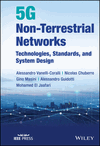Introduction
Alessandro Guidotti
CNIT, Research Unit at the University of Bologna, Italy
Search for more papers by this authorAlessandro Guidotti
CNIT, Research Unit at the University of Bologna, Italy
Search for more papers by this authorSummary
Satellite Communications can be defined as the use of artificial satellites to establish communication links between various points on the Earth's surface, i.e., a telecommunication system encompassing at least one communication satellite. The combination of the New Space era with the exploitation of low-altitude nodes led to a broadening in the family of communications from the sky: Non-Terrestrial Networks (NTN), which include the use of airborne and spaceborne nodes to establish communication links between various points on the Earth's surface. The International Telecommunication Union Radiocommunication (ITU-R) sector follows a well-established procedure to define requirements, request submissions by external organizations, and evaluate radio interface technologies for the definition of International Mobile Telecommunications-2020 (IMT-2020). Such principles and procedures are reported in ITU-R Resolution 65, and they are applicable to both the terrestrial and NTN components of IMT-2020.
References
- M. El Jaafari , N. Chuberre , S. Anjuere , L. Combelles , “ Introduction to the 3GPP-defined NTN standard: a comprehensive view on the 3GPP work on NTN ”, International Journal of Satellite Communications and Networking , vol. 41 , no. 3 , pp. 220 – 238 , 2023 . doi: 10.1002/sat.1471 .
- M. El Jaafari , N. Chuberre , “ Guest editorial IJSCN special issue on 3GPP NTN standards for future satellite communications ”, International Journal of Satellite Communications and Networking , vol. 41 , no. 3 , pp. 217 – 219 , 2023 . doi: 10.1002/sat.1472 .
- 3GPP TR 38.811 : “ Study on New Radio (NR) to support non-terrestrial networks ”, October 2020 .
- 3GPP TR 22.822 : “ Study on using satellite access in 5G ”, July 2018 .
- ITU-R Resolution 65 , “ Principles for the process of future development of IMT for 2020 and beyond ”, 2015.
- ITU-R Report M.2514-0 , “ Vision, requirements and evaluation guidelines for satellite radio interface(s) of IMT-2020 ”, September 2022 .
- ITU-R Recommendation M.2083 , “ IMT Vision – Framework and overall objectives of the future development of IMT for 2020 and beyond ”, September 2015 .
- A. Guidotti et al., “ Role and Evolution of Non-Terrestrial Networks towards 6G systems ”, to be submitted to IEEE Access , October 2023 .
- 3GPP TS 22.261 : “ Service Requirements for the 5G System ”, June 2023 .
- 3GPP TR 38.821 : “ Solutions for NR to support Non-Terrestrial Networks (NTN) ”, April 2023 .
- ITU-R, World Radiocommunication Conference 2023 (WRC-23) Provisional Final Acts, December 2023 . Available: https://www.itu.int/wrc-23/
- CEPT Weekly Reports from WRC-23 , November–December 2023. Available: https://cept.org/ecc/groups/ecc/cpg/page/weekly-report-from-wrc-23
- 3GPP, SP-180997 : “ Stage 1 CRs on SMARTER ”, December 2018 .
- 3GPP TR 23.737 : “ Study on architecture aspects for using satellite access in 5G ”, March 2021 .
- 3GPP TR 28.808 : “ Study on management and orchestration aspects of integrated satellite components in a 5G network ”, April 2021 .
- 3GPP TS 23.501 : “ System architecture for the 5G System (5GS) ”, September 2023 .
- 3GPP TS 24.821 : “ Study on PLMN selection for satellite access ”, September 2021 .
- 3GPP RP-193234 : “ Solutions for NR to support non-terrestrial networks (NTN) ”, December 2019 .
- 3GPP TS 38.321 : “ Medium Access Control (MAC) protocol specification ”, June 2023 .
- 3GPP TS 38.331 : “ NR; Radio Resource Control (RRC); Protocol specification ”, July 2023 .
- 3GPP TS 38.304 : “ NR; User Equipment (UE) procedures in idle mode and in RRC Inactive state ”, July 2023 .
- 3GPP TS 38.300 : “ NR; NR and NG-RAN Overall description; Stage-2 ”, June 2023 .
- 3GPP TR 38.863 : “ Non-terrestrial networks (NTN) related RF and co-existence aspects ”, April 2023 .
- 3GPP TS 38.101-5 : “ NR; User Equipment (UE) radio transmission and reception; Part 5: Satellite access Radio Frequency (RF) and performance requirements ”, June 2023 .
- 3GPP TS 38.108 : “ NR; Satellite Access Node radio transmission and reception ”, June 2023 .
- 3GPP TS 38.104 : “ NR; Base Station (BS) radio transmission and reception ”, June 2023 .
- 3GPP TS 38.133 : “ NR; Requirements for support of radio resource management ”, June 2023 .
- 3GPP TS 38.101-1 : “ NR; User Equipment (UE) radio transmission and reception; Part 1: Range 1 Standalone ”, June 2023 .
- 3GPP RP-221820 : “ New SID: Study on requirements and use cases for network verified UE location for Non-Terrestrial-Networks (NTN) in NR ”, June 2022 .
- 3GPP TR 38.882 : “ Study on requirements and use cases for network verified UE location for Non-Terrestrial-Networks (NTN) in NR ”, June 2022 .
- 3GPP RP-223534 : “ Revised WID: NR NTN (Non-Terrestrial Networks) enhancements ”, December 2022 .
- 3GPP TR 36.763 : “ Study on Narrow-Band Internet of Things (NB-IoT) / enhanced Machine Type Communication (eMTC) support for Non-Terrestrial Networks (NTN) ”, June 2021 .
- 3GPP TR 22.926 : “ Guidelines for extraterritorial 5G Systems (5GS) ”, December 2021 .
- 3GPP TR 22.865 : “ Study on satellite access - Phase 3 ”, June 2023 .
- 3GPP TR 21.900 : “ Technical Specification Group working methods ”, September 2023 .



